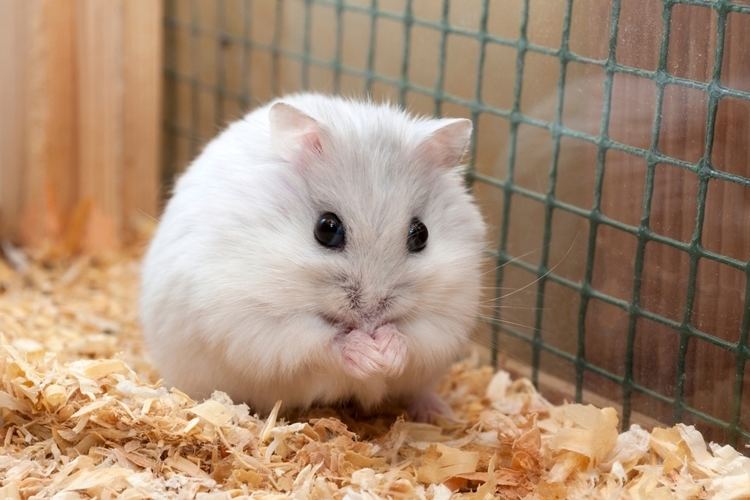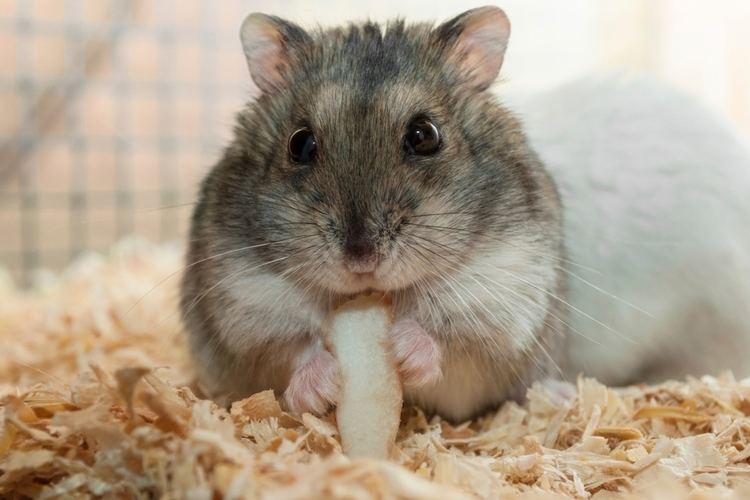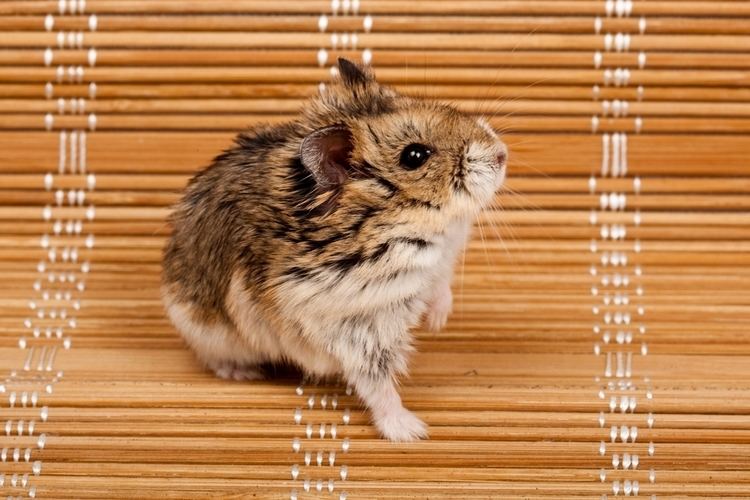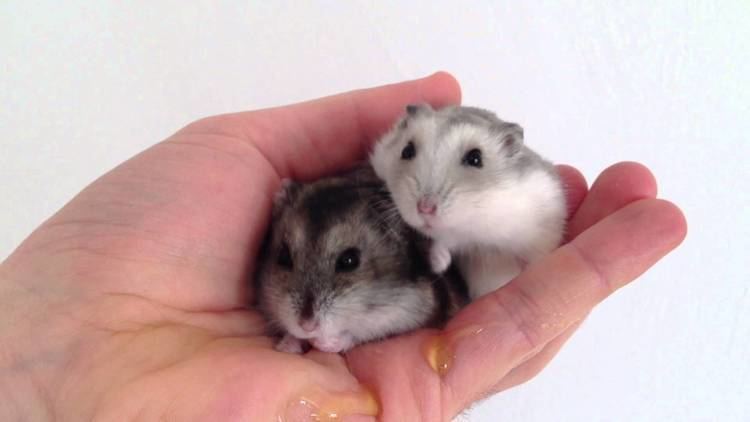Kingdom Animalia Class Mammalia Family Cricetidae Scientific name Phodopus sungorus Mass 30 g (Adult) Length 8 cm (Adult) | Phylum Chordata Order Rodentia Genus Phodopus Lifespan 12 months (In the wild) Gestation period 21 days Trophic level Omnivorous | |
 | ||
Similar Hamster, Golden hamster, Roborovski hamster, Asiatic dwarf hamsters, Rodent | ||
Djungarian hamster
The Djungarian hamster (Phodopus sungorus), also known as the Siberian hamster, Siberian dwarf hamster or Russian winter white dwarf hamster, is one of three species of hamster in the genus Phodopus. It is ball-shaped and typically half the size of the Syrian hamster, and therefore called a dwarf hamster along with all Phodopus species. Features of the Djungarian hamster include a typically thick, dark grey dorsal stripe and furry feet. As winter approaches and the days shorten, the Djungarian hamster's dark fur is almost entirely replaced with white fur. In captivity, this does not always happen. In the wild, they originate from Dzungaria, the wheat fields of Kazakhstan, the meadows of Mongolia, Siberia, and the birch stands of Manchuria.
Contents
- Djungarian hamster
- Baby djungarian hamsters winter white dwarf breed
- Physical description
- In the wild
- Systematics
- Pet ownership
- Breeding
- Hybrids
- References

Djungarian hamsters are common as pets in Europe and North America, and exhibit greater variance in their coats than those found in the wild. They reproduce often—more so than Syrian hamsters—and, as they have no fixed breeding season, can continue to produce large amounts of offspring all year round. Young pups will act aggressively to one another, while breeding females may show similar aggression to males.

Baby djungarian hamsters winter white dwarf breed
Physical description

The coat of the Djungarian hamster is less woolly than that of the Campbell's dwarf hamster, and apart from the normal colouring, they can be coloured sapphire, sapphire pearl, or normal pearl. The head length of the Djungarian hamster is 70 to 90 millimetres in length, the length of the tail is five to 15 millimetres, and the hind legs are 11 to 15 millimetres. The body weight changes dramatically throughout the year. It is at its lowest during the winter months. In males, the body weight ranges from 19 grams (0.67 oz) to 45 grams (1.6 oz), and in females, 19 grams (0.67 oz) to 36 grams (1.3 oz). In human care, they are slightly heavier. The average lifespan of the Djungarian hamster is one to three years of age in captivity, though they can live longer. In the wild, they are known to live as little as one year.

In summer, the fur of the Djungarian hamster on the back changes from ash-grey to dark brown, or sometimes pale brown with a tint. The face changes to grey or brown, while the mouth area, the whisker area and the ears are slightly brighter. The outer ears and the eyes have black edges. The rest of the head is dark brown or black. From the head to the tail runs a black-brown dorsal stripe. The throat, belly, tail and limbs are white. The ears are grey with a pinkish tint with scattered black hairs. The hairs on the underside are completely white. The bright coat the bottom extends to the shoulders, flanks and hips in three arches upward. It is distinguished from the darker fur on the top of the existing black-brown hair, three curved line.

Apart from the typical colouration, Djungarian hamsters can also be coloured pearl, sapphire, sapphire pearl and marbled. Other colorations are available, but these are strongly suspected to appear only in hybrid crossings with Campbell Dwarf hamsters. Some of these colorations are mandarin, blue, argente, yellow blue fawn, camel, brown, cream, merle and umbrous.
In the winter, the fur is more dense. They sometimes have a grey tint on their head. More than ten percent of the hamsters kept in the first winter develop the summer coat. In the second winter, only a few change into the winter coat and winter colour is less pronounced. The moulting in the winter fur starts in October or November and is completed in December, while the summer coat begins in January or February and is completed in March or early April. The ears are grey with a pinkish tint. Moulting both run jobs on the head and the back of the spine to the sides, the legs and the underside. The hairs grow longer in the summer, to about ten millimetres long.
The pigmentation of hair is controlled by the hormone prolactin and colour genetics. Day length must be less than fourteen hours to initiate the change to winter coat. The change to the winter coat can be triggered in the summer by the short day lengths. The change occurs back to the summer coat in the autumn, when the length of the days change again. At internal temperatures hamsters in captivity start later with the changes. The winter colour is less pronounced in them. The eyes of the Djungarian hamster are black, unless it is albino in which case they are red.
In the wild
In the wild, the Djungarian hamster's fur changes colour in the winter. This adaptation helps them to evade predators in the snow-covered steppes of winter. The Djungarian hamster digs tunnels one metre deep leading to ground burrows where they can sleep, raise their young and hide from predators. The weasel is one of the Djungarian hamsters main predators. Most of these burrows have six entrances. In the summer time, the burrows are lined with moss. To keep the burrow warm in the winter, the Djungarian hamster closes all but one entrance and lines the burrows with animal fur or wool that it finds. The temperature inside the burrow is usually 16.7 °C (62.1 °F). Djungarian hamsters sometimes live in the semi-deserts in Central Asia. They also live in the dry steppes and wheat or alfalfa fields as well as on small fields in the forests of the region around Minusinsk. The fur on the Djungarian hamster's feet protect the feet from the cold ground from in the cold climates in the wild. The population density is highly varied. In 1968, the first four examples of the Djungarian hamster were caught in Western Siberia and brought to the Max Planck Institute in Germany.
Systematics
The Djungarian hamster is a species of Phodopus. The Campbell's Dwarf Hamster is named as a separate species within the Phodopus sungorus species with respect to subspecies. Other subspecies are not distinguished. The Djungarian hamster was described by Peter Simon Pallas in 1773 as a mouse. The species name sungorus derives from the Dsungaria. In 1778, Pallas renamed the Djungarian hamster to mouse songarus. Ned Hollister ordered the Djungarian hamster in 1912 to the genus Phodopus. A. I. Argiropulo, in 1933, changed the name to priority sungorus and united the Djungarian hamster as a subspecies of Phodopus sungorus sungorus with the Campbell's Dwarf Hamster.
Pet ownership
Djungarian hamsters are often found on the pet market in Europe and North America. Care of the Djungarian hamster is similar to all other species of Phodopus. Djungarian hamsters, along with most rodents, are prone to tumours. They can also receive injury in the cheek pouch by sharp objects damaging the fragile inner lining. Other health problems include bite wounds, broken teeth, constipation, dehydration, dental malocclusion, diarrhea and ear problems. The Djungarian hamster is easy to tame. In addition to natural colourings in the wild ("ruddy" or "agouti"), Djungarian hamsters in captivity come in a variety of different colors.
Breeding
Djungarian hamsters reproduce at a faster rate than Syrian hamsters. Phodopus are able to become pregnant again on the same day that they have given birth. This can all happen within a thirty-six-day period. This is done as a survival strategy to produce large numbers of offspring in a short period of time. This places tremendous demands on the mother. Research suggests biparental care in Campbell's hamsters (Phodopus campbelli) but not in Djungarian hamsters (Phodopus sungorus). Frequent fighting can occur between the pups and as soon as they are weaned from their mother, they are separated from their mother. They should not be separated from their mother before three weeks of age. Most Djungarian hamster dwarf hamsters grow to 3 to 4" long. Djungarian hamsters breed all year round as there is no specific breeding season.
During the breeding time, the Djungarian hamster may become aggressive. After mating, the female may want to attack the male to protect her babies. The male will usually hide in holes or caves to escape from the vicious bite of the female Djungarian hamster. The Djungarian hamster's estrous cycle lasts four days, this means every four days, the female may accept the male back to breed again. This usually occurs when the darkness of the evening sets in. If a male and female Djungarian hamster are not housed together from a young age, it is difficult to tell if the female is willing to breed with the male.
Hybrids
Of the five species kept commonly as pets, only the Campbell's dwarf hamster and Djungarian hamsters are able to interbreed and produce live offspring or hybrids. Although hybrids make suitable pets, the breeding of hybrids and cloning can cause health and reproduction problems. In addition, the widespread breeding and distribution of hybrids could threaten the existence of both pure species and subspecies of the ecosystem, resulting in only mongrels. Hybridizing causes each litter to become smaller and the young begin to form congenital problems.
